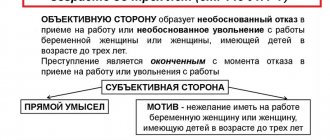Concept and subject of family law and family law
The phrase (term) “family law” is used to denote various kinds of concepts.
Firstly, family law is spoken of as a set (system) of norms regulating family relations.
Secondly, sometimes family law refers to a set (system) of regulations containing family law norms, i.e. family law.
Thirdly, family law refers to the body (system) of knowledge about family legal phenomena, i.e. science (family law as a science).
And finally, fourthly, the academic discipline “Family Law” is taught in educational institutions.
The subject of family law is a set (system) of relations regulated by the relevant branch of law (family relations).
It is clear that characterizing this kind of social connections is hardly possible without defining the key concept of what a family is. About 100 years ago V.I. Sinaisky pointed out: “Unfortunately, in our law the concept of family is devoid of any certainty and clarity” <1>. Since then, little has changed on this issue. There is still no legal definition of family (and is it even necessary?). In various branches of legislation (civil, housing, labor, etc.) the concept of family has different content. As before, disputes continue in legal science <2>.
———————————
<1> Sinaisky V.I. Russian civil law. M.: Statute, 2002. P. 483.
<2> For a review of opinions, see: Pchelintseva L.M. Family law of Russia: Textbook for universities. M., 1999. S. 2 - 6.
It seems that from a legal point of view the concept of “family”
does not and cannot have a clear and unshakable content.
the circle of family members
is another matter . The law, “starting” from the everyday understanding of the family, and pursuing certain goals, indicates who should be classified as family members. At the same time, one cannot deny the presence of a fair amount of subjectivity.
Of course, during the creation of the law there is not and cannot be unlimited arbitrariness (that is why it is said that the law “starts” from the everyday understanding of the family). But our idea of the family is changing, and the law is changing. At the same time, the discretion of the legislator cannot be ignored.
According to G.F. Shershenevich, a family is a union of persons related by marriage and persons descended from them <1>. In Art. 2 of the Family Code of the Russian Federation, family members include spouses, parents and children (adoptive parents and adopted children). At the same time, it is indicated that family legislation, in cases and within the limits provided for by law, also regulates relations between other relatives and other persons and, in addition, determines the forms and procedure for placing children left without parental care into the family.
———————————
<1> See: Shershenevich G.F. Textbook of Russian civil law (according to the 1907 edition). M., 1995. P. 406.
The concept of family is understood rather instinctively. The law, on the one hand, reflects this concept, and on the other hand, regulates certain areas of social ties that are adjacent to family relationships themselves, and sometimes in real life they are them. Being regulated by the norms of family law, all these social connections are conventionally called family relations.
The family is a social phenomenon <1>. “The family, according to Soviet scientists, is a complex complex of natural-biological, psychological, spiritual, and material connections. Not all of their elements accept legal regulation” <2>.
———————————
<1> According to G.F. Shershenevich, the family is “the main unit of the state organism” (G.F. Shershenevich, op. cit. p. 407). According to G.V. To Plekhanov, the family represents a natural unit of society (see: G.V. Plekhanov, On the question of the development of a monistic view of history. M., 1949, p. 146).
<2> Soviet family law: Textbook / Ed. V.A. Ryasentseva. M., 1982. P. 5 (author of the chapter - V.F. Yakovlev).
Therefore, I think it should be recognized that the law
, without defining the family, without trying to regulate “everything and everything” related to the family,
it defines the rights and responsibilities of family members
(and some other persons). The right is not capable of more.
It is very important that relationships regulated by family law arise on the basis of marriage, kinship, adoption, guardianship and trusteeship, and adoption of children.
Relations included in the subject of family law are characterized by the fact that their subjects are individuals
. At the same time, family legislation contains a number of norms “addressed” to other persons (for example, guardianship and trusteeship authorities).
Family relationships are ongoing
and are usually of
a personal nature
.
Family law regulates non-property and property relations that develop between family members and, in cases provided for by law, between other persons.
Non-property
Relationships regulated by family law are heterogeneous.
First of all, personal non-property
relations should be highlighted. For example, in accordance with the rule contained in Art. 32 of the RF IC, spouses, at their own discretion, choose, upon marriage, the surname of one of them as a common surname, or each spouse retains their premarital surname, or, unless otherwise provided by the laws of the constituent entities of the Russian Federation, adds the surname of the other spouse to their surname. It is generally accepted that personal non-property relations, in comparison with property relations, have a priority nature, since property relations are always associated with them and follow from them <1>.
———————————
<1> See about this: Pchelintseva L.M. Decree. op. P. 8. N.D. holds the opposite point of view. Egorov (see: Civil law: Textbook. In 3 volumes. T. 3. 4th ed., revised and supplemented. / Edited by A.P. Sergeev, Yu.K. Tolstoy. M.: Prospekt, 2004. P. 296 et seq.).
It seems that family law also regulates such non-property relations as organizational
, i.e. aimed at streamlining (normalizing) other social relations and the actions of their participants <2>. These include, in particular, many relationships that develop regarding marriage (see, for example, Articles 10, 15 of the Family Code), in the process of identifying and accounting for children left without parental care (Article 122 of the Family Code), etc. .
———————————
<2> See: Krasavchikov O.A. Civil organizational and legal relations // Categories of science of civil law: Selected works. In 2 volumes. T. 1. M.: Statute, 2005. P. 45.
The most important provisions regarding the regulation of property
relations (including those included in the subject of family law) are concentrated in the Civil Code of the Russian Federation (hereinafter referred to as the Civil Code, Civil Code of the Russian Federation, Civil Code). They have been developed in family law. Thus, the RF IC contains a number of rules on the property of spouses (Articles 33 - 44), on the responsibility of spouses for obligations (Articles 45, 46), on the property rights of the child (Article 60), on alimony obligations (Article 80 - 120).
Characterizing the family law method
, i.e.
the way family law influences the social relations it regulates, first of all, it is necessary to pay attention to the predominance in family law of imperative
norms, rules prescribing a certain type of behavior. Of course, imposing a duty on one of the participants in family relations means simultaneously granting the right to another (other) participant, just as the granting of a subjective right inevitably presupposes the incurrence by someone of an obligation corresponding to this right. (Otherwise there will be “bare” law.) But in family law, in all these cases, subjects are deprived of the opportunity to choose options for behavior - there is no dispositivity. Thus, family legislation is based on the principle of voluntariness of a marriage between a man and a woman (Clause 3, Article 1 of the Family Code). However, the conditions and procedure for concluding a marriage are determined by imperative norms (Articles 10 - 15 of the Family Code). A marriage can be terminated by dissolution, i.e. at the will of one or both spouses. But even here, discretion in a number of cases is limited by imperative instructions. Thus, the husband does not have the right, without the consent of his wife, to initiate proceedings for divorce during the wife’s pregnancy and within a year after the birth of the child (Article 17 of the Family Code). Divorce in court is carried out if the court determines that further life together of the spouses and the preservation of the family is impossible. The court may take measures to reconcile the spouses and has the right to postpone the hearing of the case, assigning the spouses a period for reconciliation (Article 22 of the Criminal Code). In these cases, the discretion of the spouses is subject to the control of the court. The norms of family law on the invalidity of marriage (Articles 27 - 29 of the Family Code) are, naturally, imperative, just like the rules on the legal regime of the property of spouses (Articles 33 - 39 of the Family Code) and on the liability of spouses for obligations (Articles 45, 46 SK). Imperative norms regulate the establishment of the origin of children (Articles 47 - 53 of the Family Code). Most family law norms prescribe a certain type of behavior, thereby limiting the discretion of participants in family relationships. In a number of cases, interference in the affairs of the family by the court, guardianship and trusteeship authorities is allowed, which also limits the freedom to choose behavior. Some family rights are at the same time the obligations of the participants in the relevant relationship. Thus, parents have the right and obligation to raise their children (Clause 1, Article 63 of the Family Code).
So, the family law method can be characterized as imperative.
Of course, family law also contains dispositive norms
, i.e.
rules that allow the ability to determine one’s behavior by one’s own will and choose a behavior option. The latest family legislation is marked by the strengthening of the dispositive principle.
Thus, it became possible to conclude a marriage contract, an agreement on the payment of alimony, etc. However, discretion in family law differs quite significantly from the usual understanding of discretion. For example, discretion in the norms of the law of obligations is manifested in defining an option of behavior and allowing the parties to establish otherwise by agreement, or in providing the opportunity to regulate relations at the discretion of the parties, or in indicating a number of options of behavior from which a choice can be made. Dispositiveness is limited by the framework outlined by imperative norms. And nothing more. In family law, imperativeness is more important. And it’s not just the number of imperative norms. In family law, discretion exists not only within the limits determined by imperative norms, but also under “control”. The law, allowing for the regulation of family relations by agreement of the parties (allowing the choice of behavior options), fears abuse (of all or individual participants in the relevant relationship), infringement of the rights of the “weak” participant in family relations (for example, a child). Therefore, every time it is possible to ignore the manifestation of discretion. Thus, a marriage contract can determine the property rights and obligations of spouses during marriage and (or) in the event of its dissolution (Article 40 of the Family Code). However, the court can declare a marriage contract invalid not only on the grounds provided for by the Civil Code for the invalidity of transactions, but also “at the request of one of the spouses, if the terms of the contract place this spouse in an extremely unfavorable position” (Article 44 of the Family Code). It is permissible to conclude an agreement on the payment of alimony (Article 99 of the Family Code). But the agreement may be declared invalid if its terms significantly violate the interests of the alimony recipient (Article 102 of the Family Code). Thus, the law, allowing discretion in the regulation of family relations, allows, taking into account the specific circumstances of each specific case, to ignore the will of the participants in the relevant relationship.
As a result, it turns out that dispositivity
in family law,
it is “subordinate” not only to the law, but also to judicial discretion
(subsequent judicial review is allowed).
Taking into account the above, the method of family law can be defined as imperative with some assumption of dispositivity, and dispositivity (freedom to choose an option of behavior, the ability to act at one’s own discretion) can be “crossed out” by a court decision, i.e. replaced by imperative indication <1>.
———————————
<1> The question of the method of family law is one of the controversial ones. So, E.M. Vorozheikin pointed out that Soviet family law is characterized by the imperative nature of most norms, but did not reject the advisability of using dispositive rules (see: Belyakova A.M., Vorozheikin E.M. Soviet family law. M.: Yurid. lit., 1974. P. 12); V.F. Yakovlev believed that the method of family law in terms of the content of the impact on relationships is permissible, and in the form of instructions - imperative (see: Soviet family law: Textbook / Edited by V.A. Ryasentsev. P. 11. See also: Pchelintseva L .M. Op. op. pp. 12 - 15), and M.V. Antokolskaya believes that the method of family law can be characterized in general as dispositive and situational (see: Antokolskaya M.V. Family Law: Textbook. 2nd ed., revised and supplemented. M.: Yurist, 2004. P. 21 - 31).
Source: Textbook "FAMILY LAW" edited by P.V. KRASHENINNIKOVA. Authors: Gongalo B.M., Krasheninnikov P.V., Mikheeva L.Yu., Ruzakova O.A.
Positive and negative aspects of civil marriage
According to surveys of people who prefer “civil marriage” to official relationships, this format of cohabitation has the following positive aspects:
- The opportunity to test the strength of your relationship in the process of living together;
- Maintaining the status of a free citizen with the actual presence of a family;
- Saving money on organizing a wedding celebration;
- The opportunity to get an education, build a career and prepare the material base for future family relationships;
- The acquired property is not jointly acquired, which makes it possible to preserve it if there are claims on the part of the partner.
Read also: Registration of a newborn child
Despite the advantages in relationships of this format, cohabitation also has a number of disadvantages. These include:
- There are frequent cases of misunderstanding on the part of government agencies and institutions, because such a couple is not considered a family by law;
- In the absence of a will, the cohabitant will not be able to inherit the property of the partner in the event of his death;
- When a couple separates, they will have to go through a complex procedure to divide property, which is regulated by the norms of the Civil Code of the Russian Federation;
- Inability to draw up a marriage contract.
In the case of living together in order to get to know each other better, a “civil marriage” often lasts a fairly long period of time and may not lead to registration of the relationship. This is due to the fact that when the partners have taken a closer look at each other and have established everyday life, many look at a trip to the registry office as a formality that means nothing for an already established union.







